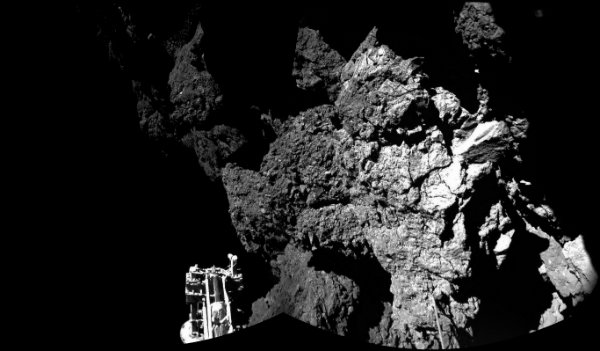European Space Agency scientists are attempting to determine exactly where their robotic lander Philae has come to rest on comet 67P/Churyumov–Gerasimenko, but have confirmed that the first-ever soft landing on a comet was a success.
Touchdown on 67P was confirmed at 1603 GMT on Tuesday 12 November, after a seven-hour, 22.5km unguided descent from Philae’s parent ship, Rosetta, which is orbiting the comet some 510 million km from Earth.
Philae has also returned its first photos from the surface (below), and in its first 2.5 days will conduct its primary science mission, assuming that its main battery remains in good health. With data gathered by Rosetta and Philae, scientists hope to reveal secrets of the origin of the Solar System, and even of life on Earth, as comets are possibly the oldest fragments of the Sun’s early environment.

First image from surface of 67P; one lander leg visible in lower left
ESA
“Rosetta is trying to answer the very big questions about the history of our Solar System. What were the conditions like at its infancy and how did it evolve? What role did comets play in this evolution? How do comets work?” says Matt Taylor, ESA Rosetta project scientist.
But the lander – about the size of a domestic washing machine, with three legs – may have moved after touchdown, possibly rebounding off the surface before coming to rest. Early telemetry showed the landing gear to have compressed 4cm on touchdown, indicating a softer than expected contact with the surface of the comet. However, harpoon-style anchors which were supposed to have fired into the surface did not deploy automatically.
Anchoring to the surface is important because the comet is only about 4km across – roughly the size of Mt Blanc – and so has very little gravity. Also, the comet has turned out to have a highly irregular shape, like two bulbs joined by a narrow neck, as well as a surface strewn with boulders, craters and other obstacles.
“We are extremely relieved to be safely on the surface of the comet, especially given the extra challenge of the comet’s unusual shape and unexpectedly hazardous surface,” says Stephan Ulamec, Philae Lander Manager at the DLR German aerospace Centre.
Philae’s primary science mission includes recording a full panoramic view of the landing site, including a section in 3D, high-resolution images of the surface immediately underneath the lander, on-the-spot analysis of the composition of the comet’s surface materials, and deploying a drill that will take samples from a depth of 23cm and feed them to an onboard laboratory for analysis.
The lander will also measure the electrical and mechanical characteristics of the surface, and low-frequency radio signals will be beamed between Philae and the orbiter through the nucleus to probe the internal structure. The detailed surface measurements that Philae makes at its landing site will complement and calibrate the extensive remote observations made by the orbiter covering the whole comet.
An extended science phase using the rechargeable secondary battery may be possible, if the Sun's illumination conditions allow and dust settling on the solar panels does not prevent it. This extended phase could last until March 2015, after which conditions inside the lander are expected to be too hot for it to continue operating.
Rosetta was launched on 2 March 2004 and travelled 6.4 billion km through the Solar System before arriving at the comet on 6 August 2014. During that 10-year trip to rendezvous with 67P, which spends much of its orbit around the Sun beyond Jupiter, Rosetta spent an extended time in hibernation, effectively shut down and with no contact with its controllers, and relied on three gravity-assist fly-bys of Earth and one of Mars to reach the comet.
The comet will reach its closest distance to the Sun on 13 August 2015 at about 185 million km, roughly between the orbits of Earth and Mars. Rosetta will follow it throughout the remainder of 2015, as they head away from the Sun and activity begins to subside.
Source: FlightGlobal.com


























